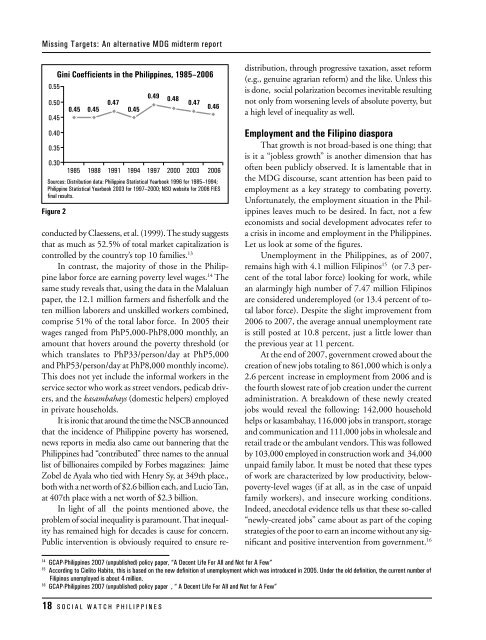one big file - Social Watch
one big file - Social Watch
one big file - Social Watch
Create successful ePaper yourself
Turn your PDF publications into a flip-book with our unique Google optimized e-Paper software.
Missing Targets: An alternative MDG midterm report<br />
0.55<br />
0.50<br />
0.45<br />
0.40<br />
0.35<br />
0.30<br />
Gini Coefficients in the Philippines, 1985–2006<br />
0.45 0.45<br />
0.47<br />
0.45<br />
0.49 0.48<br />
0.47<br />
0.46<br />
1985 1988 1991 1994 1997 2000 2003 2006<br />
Sources: Distribution data: Philippine Statistical Yearbook 1996 for 1985–1994;<br />
Philippine Statistical Yearbook 2003 for 1997–2000; NSO website for 2006 FIES<br />
final results.<br />
Figure 2<br />
conducted by Claessens, et al. (1999). The study suggests<br />
that as much as 52.5% of total market capitalization is<br />
controlled by the country’s top 10 families. 13<br />
In contrast, the majority of those in the Philippine<br />
labor force are earning poverty level wages. 14 The<br />
same study reveals that, using the data in the Malaluan<br />
paper, the 12.1 million farmers and fisherfolk and the<br />
ten million laborers and unskilled workers combined,<br />
comprise 51% of the total labor force. In 2005 their<br />
wages ranged from PhP5,000-PhP8,000 monthly, an<br />
amount that hovers around the poverty threshold (or<br />
which translates to PhP33/person/day at PhP5,000<br />
and PhP53/person/day at PhP8,000 monthly income).<br />
This does not yet include the informal workers in the<br />
service sector who work as street vendors, pedicab drivers,<br />
and the kasambahays (domestic helpers) employed<br />
in private households.<br />
It is ironic that around the time the NSCB announced<br />
that the incidence of Philippine poverty has worsened,<br />
news reports in media also came out bannering that the<br />
Philippines had “contributed” three names to the annual<br />
list of billionaires compiled by Forbes magazines: Jaime<br />
Zobel de Ayala who tied with Henry Sy, at 349th place.,<br />
both with a net worth of $2.6 billion each, and Lucio Tan,<br />
at 407th place with a net worth of $2.3 billion.<br />
In light of all the points menti<strong>one</strong>d above, the<br />
problem of social inequality is paramount. That inequality<br />
has remained high for decades is cause for concern.<br />
Public intervention is obviously required to ensure redistribution,<br />
through progressive taxation, asset reform<br />
(e.g., genuine agrarian reform) and the like. Unless this<br />
is d<strong>one</strong>, social polarization becomes inevitable resulting<br />
not only from worsening levels of absolute poverty, but<br />
a high level of inequality as well.<br />
Employment and the Filipino diaspora<br />
That growth is not broad-based is <strong>one</strong> thing; that<br />
is it a “jobless growth” is another dimension that has<br />
often been publicly observed. It is lamentable that in<br />
the MDG discourse, scant attention has been paid to<br />
employment as a key strategy to combating poverty.<br />
Unfortunately, the employment situation in the Philippines<br />
leaves much to be desired. In fact, not a few<br />
economists and social development advocates refer to<br />
a crisis in income and employment in the Philippines.<br />
Let us look at some of the figures.<br />
Unemployment in the Philippines, as of 2007,<br />
remains high with 4.1 million Filipinos 15 (or 7.3 percent<br />
of the total labor force) looking for work, while<br />
an alarmingly high number of 7.47 million Filipinos<br />
are considered underemployed (or 13.4 percent of total<br />
labor force). Despite the slight improvement from<br />
2006 to 2007, the average annual unemployment rate<br />
is still posted at 10.8 percent, just a little lower than<br />
the previous year at 11 percent.<br />
At the end of 2007, government crowed about the<br />
creation of new jobs totaling to 861,000 which is only a<br />
2.6 percent increase in employment from 2006 and is<br />
the fourth slowest rate of job creation under the current<br />
administration. A breakdown of these newly created<br />
jobs would reveal the following: 142,000 household<br />
helps or kasambahay, 116,000 jobs in transport, storage<br />
and communication and 111,000 jobs in wholesale and<br />
retail trade or the ambulant vendors. This was followed<br />
by 103,000 employed in construction work and 34,000<br />
unpaid family labor. It must be noted that these types<br />
of work are characterized by low productivity, belowpoverty-level<br />
wages (if at all, as in the case of unpaid<br />
family workers), and insecure working conditions.<br />
Indeed, anecdotal evidence tells us that these so-called<br />
“newly-created jobs” came about as part of the coping<br />
strategies of the poor to earn an income without any significant<br />
and positive intervention from government. 16<br />
14<br />
GCAP-Philippines 2007 (unpublished) policy paper, “A Decent Life For All and Not for A Few”<br />
15<br />
According to Cielito Habito, this is based on the new definition of unemployment which was introduced in 2005. Under the old definition, the current number of<br />
Filipinos unemployed is about 4 million.<br />
16<br />
GCAP-Philippines 2007 (unpublished) policy paper , “ A Decent Life For All and Not for A Few”<br />
18 S O C I A L W A T C H P H I L I P P I N E S

















